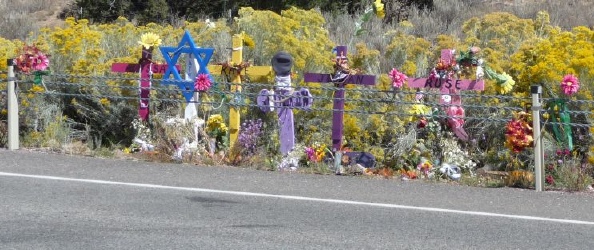In the New Mexican, Anne Constable tackles another conundrum, involving jury instruction Number 8. It is dumfounding that neither the prosecutor nor the judge in the Fierro trial noticed the defense team’s bait-and-switch: rewording the instruction to misstate the law and make it all but impossible to convict. The jurors had been told to find Mr. Fierro guilty of vehicular homicide if he was the significant cause of the accident but to acquit him if his victim, William Tenorio, was a significant cause. What? After the jurors brought this muddle to the court’s attention, the error was corrected and Mr. Fierro was found guilty. But now there is the likelihood of a mistrial in a case that should have been clear cut.

Memorial for the victims of the Old Las Vegas Highway crash
Throughout these twists and turns, the matter of Scott Owens, charged in another vehicular homicide, has taken a different path. Mr. Owens is the guy who was driving drunk late one summer night in the wrong lane of Old Las Vegas Highway when he saw, bleary eyed, a pair of headlights coming at him. He steered to the right to get back on his side of the road. At the same instant the other driver, a 16-year-old girl, tried to avoid Mr. Owens by steering left. Their paths crossed, and while Mr. Owens came out o.k., four young passengers in the other car were killed.
Unlike Mr. Fierro, Mr. Owens is taking responsibility for his recklessness and, according to the New Mexican, is negotiating a plea bargain. That might anger some of the victims’ friends. But trial or not, there is little question that Mr. Owens will serve hard time.
Imagine an alternate universe in which he goes to trial and is represented, like Mr. Fierro, by Jason Bowles and Robert Gorence. First the lawyers might seize on the fact that the teen-aged driver was operating a vehicle under a provisional license. She could not legally be on the road so late at night and, to avoid distraction, was not allowed to have more than one under-aged passenger in her car. Pressing the point, the lawyers might note that she was part of a caravan — all the drivers and passengers were juveniles — heading to Eldorado for an after-midnight party. The defense might even dredge up a discredited rumor that one of the other student’s cars swerved into Mr. Owens and initiated the chain of events — anything to manufacture doubt in the jurors’ minds.
Then, borrowing a theme from the Fierro trial, the lawyers might argue that there were no streetlights on the stretch of road where the accident occurred, and that the teen-agers who died were in a dark red Suburu, as invisible in the night as a Stealth bomber. The defense would concede that Mr. Owens was guilty of DWI but contend that the accident might have been avoided had not an inexperienced driver been at the other wheel. If only she had swerved right onto the shoulder instead of left into the other lane. If only her car had been white. Finally, just to be sure, the defense could doctor the jury instructions knowing that at worst that might result in a mistrial.
In a plea bargain, Mr. Owens might shave years off his prison term, but at least he is not trying to beat the rap. His actions, with their horrible consequences, are hard to forgive, but compared with Carlos Fierro, Scott Owens is looking like a class act.
George Johnson
The Santa Fe Review
